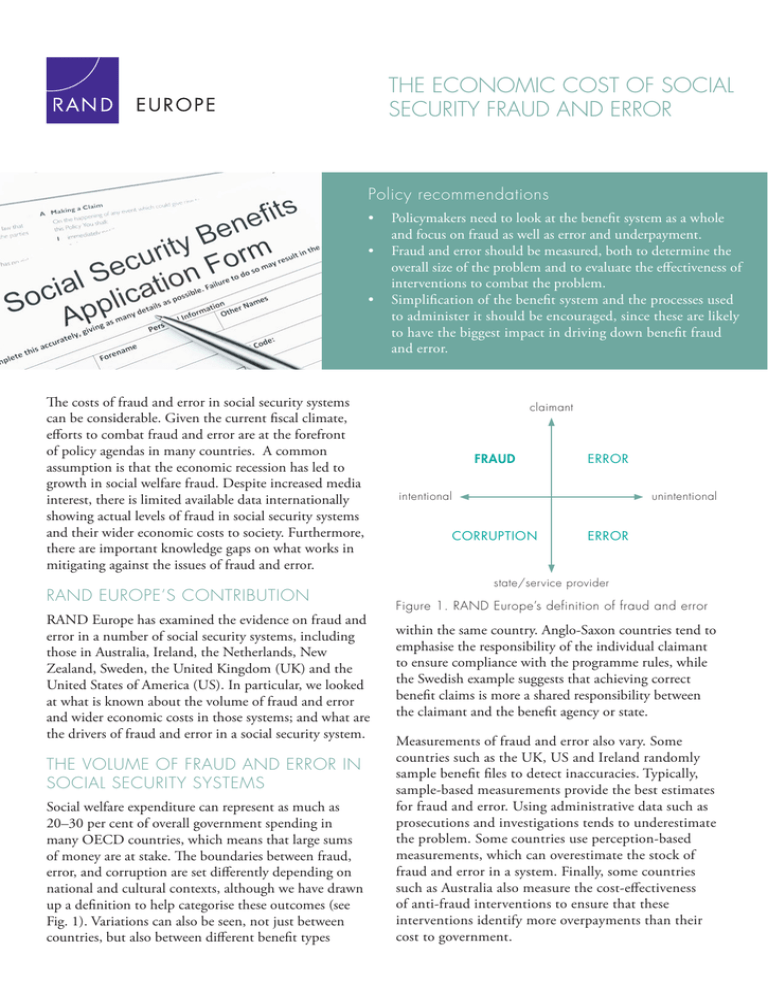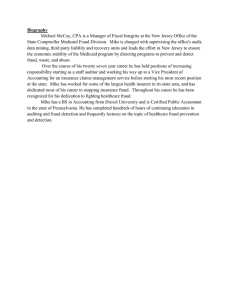THE ECONOMIC COST OF SOCIAL SECURITY FRAUD AND ERROR Policy recommendations
advertisement

THE ECONOMIC COST OF SOCIAL SECURITY FRAUD AND ERROR Policy recommendations • Policymakers need to look at the benefit system as a whole and focus on fraud as well as error and underpayment. • Fraud and error should be measured, both to determine the overall size of the problem and to evaluate the effectiveness of interventions to combat the problem. • Simplification of the benefit system and the processes used to administer it should be encouraged, since these are likely to have the biggest impact in driving down benefit fraud and error. The costs of fraud and error in social security systems can be considerable. Given the current fiscal climate, efforts to combat fraud and error are at the forefront of policy agendas in many countries. A common assumption is that the economic recession has led to growth in social welfare fraud. Despite increased media interest, there is limited available data internationally showing actual levels of fraud in social security systems and their wider economic costs to society. Furthermore, there are important knowledge gaps on what works in mitigating against the issues of fraud and error. RAND EUROPE’S CONTRIBUTION RAND Europe has examined the evidence on fraud and error in a number of social security systems, including those in Australia, Ireland, the Netherlands, New Zealand, Sweden, the United Kingdom (UK) and the United States of America (US). In particular, we looked at what is known about the volume of fraud and error and wider economic costs in those systems; and what are the drivers of fraud and error in a social security system. THE VOLUME OF FRAUD AND ERROR IN SOCIAL SECURITY SYSTEMS Social welfare expenditure can represent as much as 20–30 per cent of overall government spending in many OECD countries, which means that large sums of money are at stake. The boundaries between fraud, error, and corruption are set differently depending on national and cultural contexts, although we have drawn up a definition to help categorise these outcomes (see Fig. 1). Variations can also be seen, not just between countries, but also between different benefit types claimant FRAUD ERROR intentional unintentional CORRUPTION ERROR state/service provider Figure 1. RAND Europe’s definition of fraud and error within the same country. Anglo-Saxon countries tend to emphasise the responsibility of the individual claimant to ensure compliance with the programme rules, while the Swedish example suggests that achieving correct benefit claims is more a shared responsibility between the claimant and the benefit agency or state. Measurements of fraud and error also vary. Some countries such as the UK, US and Ireland randomly sample benefit files to detect inaccuracies. Typically, sample-based measurements provide the best estimates for fraud and error. Using administrative data such as prosecutions and investigations tends to underestimate the problem. Some countries use perception-based measurements, which can overestimate the stock of fraud and error in a system. Finally, some countries such as Australia also measure the cost-effectiveness of anti-fraud interventions to ensure that these interventions identify more overpayments than their cost to government. THE CHALLENGE OF CROSS-COUNTRY COMPARISONS These differences in how each country defines and measures fraud and error hinder comparisons between countries. Our evidence gives some indications of fraud and error rates across benefit types in seven OECD countries. The average level of fraud and error in meanstested benefits is around 5–10 per cent of overall benefit expenditure, 1–2 per cent in unemployment benefits and disability programmes, and 0.1–1 per cent in oldage pension benefits and child benefits. In pensions and category-based benefits it is difficult to misrepresent the qualifications of claimants. Overall, benefit fraud and error account for, on average, 2–5 per cent of social security budgets. An observation across several of the social security systems studied is that customer and official error can be a more significant problem (and is becoming a more important issue) than fraud. There is only anecdotal evidence of a relationship between a nation’s economic climate and benefit fraud. Taking the UK as an example, official data indicate that the economic climate since 2008 has not impacted on benefit fraud significantly. In fact, benefit fraud has remained largely stable since 2008. However, the UK may very well be an outlier given that its government has placed a strong emphasis on mitigating fraud and error over time. While fraud receives a lot of attention, inaccuracies in benefit payments can also disadvantage claimants. In the UK, underpayments are estimated to represent a greater sum than overpayments, and are often neglected when determining economic costs. In 2013, the UK Department of Work and Pensions estimated benefit fraud in the UK at £1.2 billion and underpayments due to error at £1.6 billion. DRIVERS OF FRAUD AND ERROR Our work finds that the complexity of a benefit system, in terms of both number of benefits and eligibility requirements, appears to be associated with high levels of fraud. This is borne out by an analysis of the main drivers of fraud and error: • • • • • Customer dishonesty: undeclared income and failing to report changes in material circumstances Exploiting the system: multiple programme claims and misrepresentation of material circumstances and identity fraud Complexity of the social protection system: multitude of benefits and rules, lack of clarity and possibility for cross-jurisdictional claims, confusion among both administrators and benefit claimants Staff: excessive staff caseloads, inadequate support and training of case managers and team coaches, breakdown or override of internal control System: failure of payment systems, failure of IT systems, problematic information management, and inadequate monitoring or reporting procedures CONCLUSIONS Establishing the economic cost of benefit fraud across social security administrations is constrained by how fraud is defined in different national and cultural contexts and whether fraud is measured in a systematic way. Our review of the available evidence across a number of OECD countries concludes that: • • • • fraud and error can represent a substantial loss to the taxpayer in OECD countries, accounting for an average of 2–5 per cent of social security budgets; error can be a more significant (costly) problem than fraud; the economic climate, based on UK data, does not appear to have much impact on the volume of fraud in the system; and the complexity of rules and benefits seems to be the main driver of fraud and error. WANT TO LEARN MORE? Christian van Stolk is Director of Home Affairs and Social Policy, RAND Europe, and has an extensive track record in national, European and international projects on social and employment policies, including human capital development, performance measurement, public sector governance and social security systems. stolk@rand.org © Copyright 2014 RAND Corporation. RAND Europe is an independent, not-for-profit policy research organisation that aims to help improve policy and decisionmaking through research and analysis. RAND’s publications do not necessarily reflect the opinions of its research clients and sponsors. RA® is a registered trademark. www.randeurope.org WESTBROOK CENTRE MILTON ROAD CAMBRIDGE CB4 1YG UNITED KINGDOM TEL +44.1223.353.329 FAX +44.1223.358.845 RUE DE LA LOI, 82 1040 BRUSSELS BELGIUM TEL +32.2.669.2400 CP-806 CHILDREN AND FAMILIES EDUCATION AND THE ARTS The RAND Corporation is a nonprofit institution that helps improve policy and decisionmaking through research and analysis. ENERGY AND ENVIRONMENT HEALTH AND HEALTH CARE INFRASTRUCTURE AND TRANSPORTATION This electronic document was made available from www.rand.org as a public service of the RAND Corporation. INTERNATIONAL AFFAIRS LAW AND BUSINESS NATIONAL SECURITY POPULATION AND AGING PUBLIC SAFETY SCIENCE AND TECHNOLOGY TERRORISM AND HOMELAND SECURITY Support RAND Browse Reports & Bookstore Make a charitable contribution For More Information Visit RAND at www.rand.org Explore RAND Europe View document details Corporate Publications This product is part of the RAND Corporation corporate publication series. Corporate publications describe or promote RAND divisions and programs, summarize research results, or announce upcoming events. Limited Electronic Distribution Rights This document and trademark(s) contained herein are protected by law as indicated in a notice appearing later in this work. This electronic representation of RAND intellectual property is provided for non-commercial use only. Unauthorized posting of RAND electronic documents to a non-RAND Web site is prohibited. RAND electronic documents are protected under copyright law. Permission is required from RAND to reproduce, or reuse in another form, any of our research documents for commercial use. For information on reprint and linking permissions, please see RAND Permissions.



